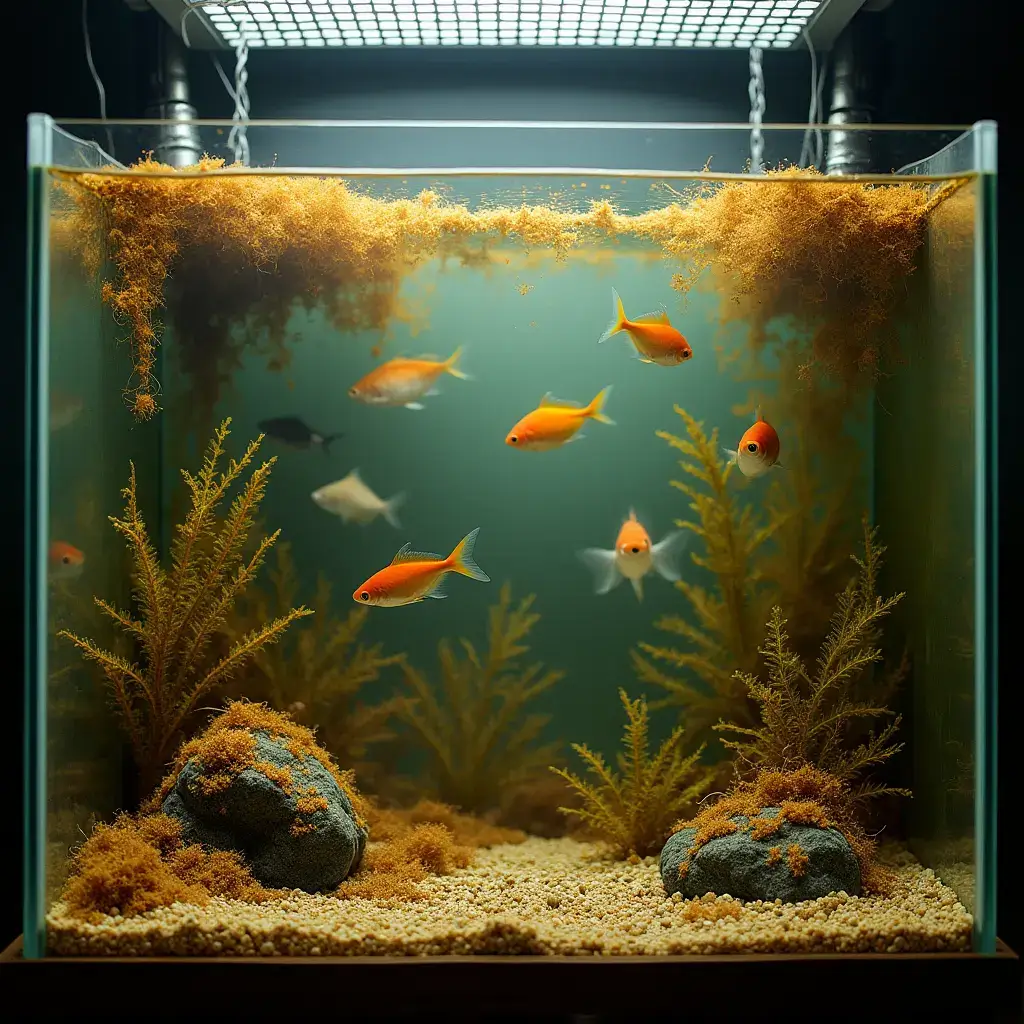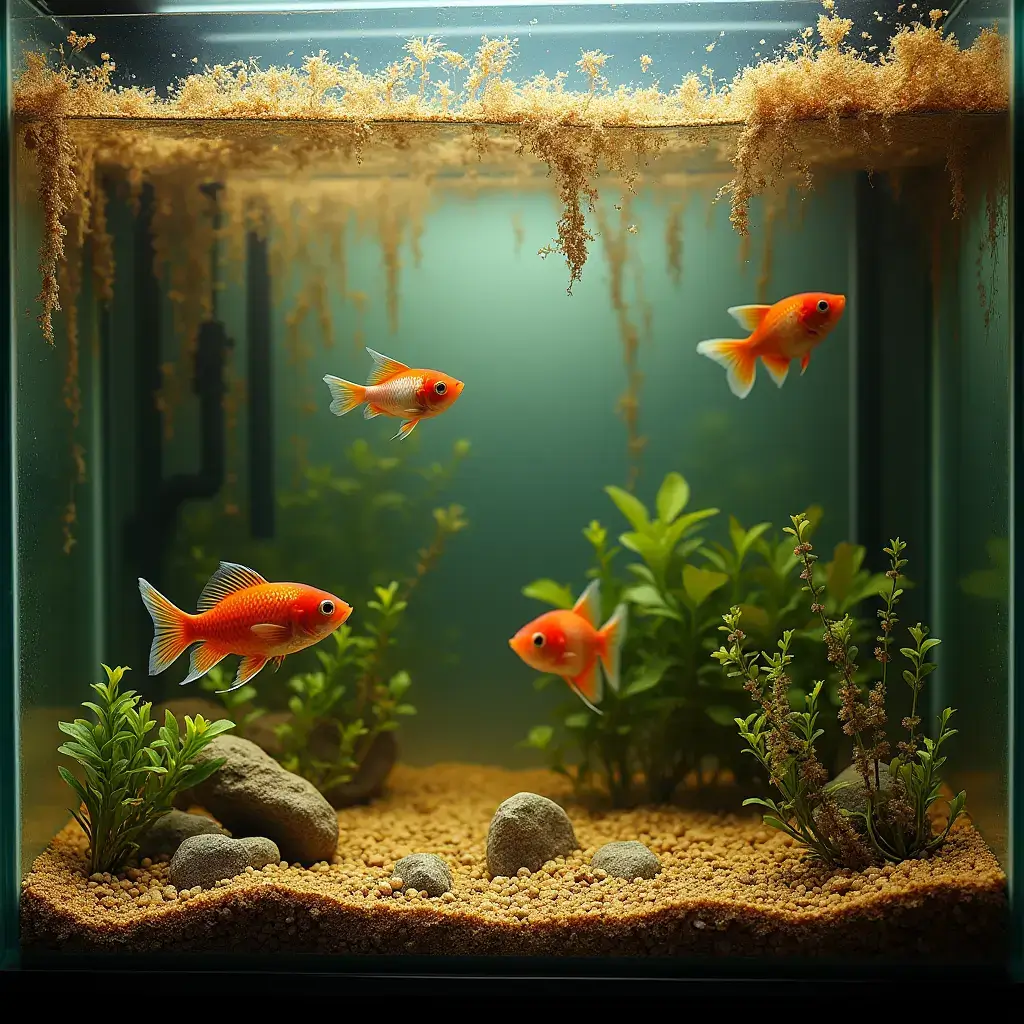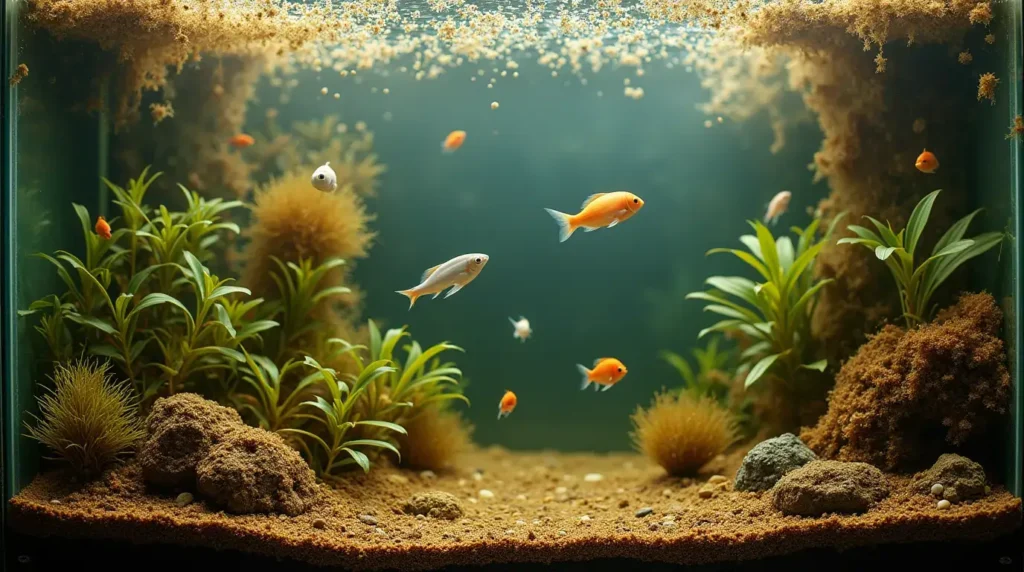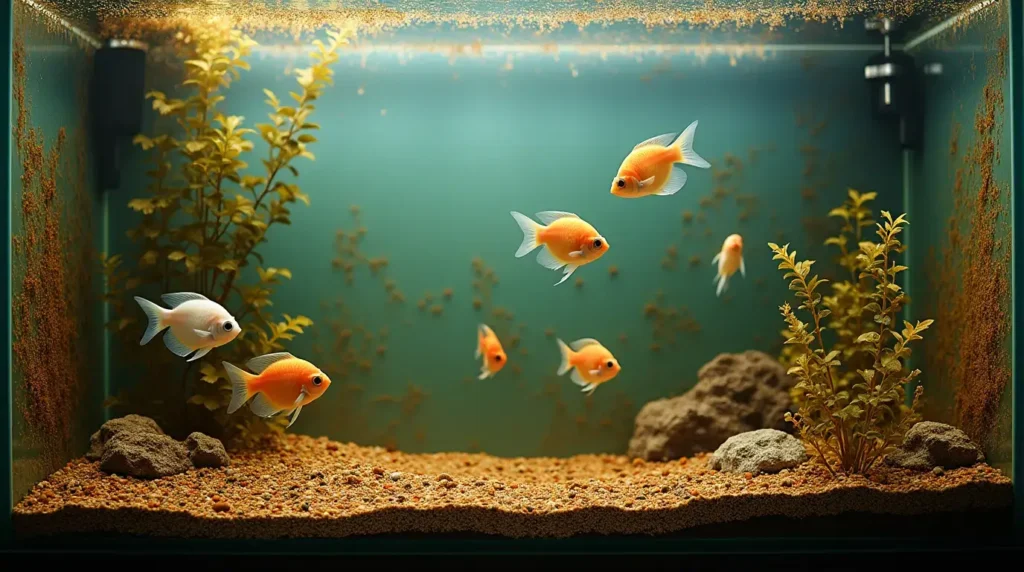Ever seen a brown, slimy coating in your aquarium? That’s brown algae, also known as diatoms or silica algae. It’s common in new fish tanks, especially when they’re cycling. While it won’t harm your fish, it can ruin the look of your tank.
But don’t worry, you can fight this algae. By understanding why it grows and how to stop it, you can keep your tank looking great. Let’s dive into the science and solutions to keep your fish tank healthy and beautiful.


Table of Contents
Understanding Brown Algae: Diatoms in the Aquarium
Have you seen a brown, slimy film in your fish tank? This is likely diatom algae, also known as “brown algae.” These tiny organisms, called diatoms, are common in new aquariums. They can greatly affect the tank’s ecosystem.
The Science Behind Diatom Formation
Diatoms are special because they can make their own food using light. They have a unique, opal-like covering that protects them. Unlike other algae, diatoms don’t move and settle at the bottom, creating a brown film.
How Diatoms Differ from True Algae
Diatoms are not the same as true algae. They don’t make harmful toxins and don’t directly harm fish. But, their fast growth can ruin the tank’s look and balance.
Impact on Aquarium Ecosystem
Diatoms aren’t harmful on their own. However, an excess of them can lead to issues. They can take over nutrients meant for plants, upsetting the ecosystem. Also, their thick film can block light, harming plant growth.
Knowing how diatoms work is key to controlling them in your tank. By tackling the reasons they grow, you can keep your aquarium healthy and balanced.
“Diatoms are often a sign of an immature or unbalanced aquarium ecosystem, but with the right approach, you can get them under control and maintain a healthy, vibrant tank environment.”
Common Signs and Symptoms of Brown Algae Growth
Spotting brown algae in your aquarium is key for keeping it clean. This algae looks like a thin, brown film on surfaces. It’s different from blue-green algae because it doesn’t form big, slimy sheets. Instead, it has a dusty look that dulls your tank’s brightness.
A dull tank is a sign of brown algae. Surfaces might look brown, and the gravel could seem dusty. This is especially true in new tanks or those in darker spots.
| Symptom | Description |
|---|---|
| Thin, Brown Coating | Brown algae appear as a thin, brown coating on gravel, glass, and other surfaces in the aquarium. |
| Dusty Appearance | The surfaces in the tank may have a dusty, dull look due to the brown algae growth. |
| General Dullness | The overall appearance of the tank can become less vibrant and more dull due to the brown algae. |
| Prevalence in New Tanks | Brown algae are more common in newly set up aquariums or tanks kept in darker locations. |
If you notice these signs, it’s time to take action. Proper tank maintenance, algae identification, and aquarium cleanliness are crucial. They help control brown algae and keep your tank healthy for your fish and plants.
Brown Algae in Fish Tanks: Primary Causes and Risk Factors
Keeping your aquarium healthy and vibrant means knowing why brown algae grows. These algae need certain water conditions, light, and nutrients to thrive. Understanding these needs is key to stopping their growth.
Silica Levels and Water Chemistry
High silica levels in your tank can lead to brown algae. Silica can come from tap water or certain substrates. Also, water chemistry issues like pH, temperature, and oxygen levels can help these algae grow.
Lighting Conditions
Not enough light or a dark tank can make brown algae worse. Since diatoms need light to grow, bad lighting can cause them to bloom. This can make your tank look bad and cause problems.
Nutrient Imbalances
Too many nutrients, like nitrates and phosphates, can also cause algae. These can come from leftover fish food, overfeeding, or poor water care. Without control, these nutrients can let algae grow too much.
Knowing why brown algae grows is important for keeping your tank healthy. By fixing water, light, and nutrient issues, you can stop algae. This helps keep your aquarium balanced and beautiful.
“Maintaining a balanced and thriving aquarium ecosystem requires careful attention, and tackling the underlying causes of brown algae is essential for ensuring your tank remains vibrant and healthy.“
The Connection Between New Tank Syndrome and Brown Algae
Many aquarium fans face the challenge of “new tank syndrome.” This issue is closely tied to brown algae, or diatoms, in new tanks. Knowing this link can help you manage the cycling process and avoid algae problems.
When you start your new aquarium setup, the tank’s ecosystem is in a delicate balance. Beneficial bacteria start to grow, creating a perfect environment for diatoms. These algae show up as a brownish-yellow film on glass, decorations, and plants.
The algae outbreak in a new tank is a natural step. As the tank matures and bacteria grow, silica levels drop. This leads to less diatom growth, ending the new tank syndrome and starting a balanced aquarium.
“The success of a new aquarium setup depends on understanding the cycling process and managing the natural algae growth that often accompanies it.”
Knowing the link between new tank syndrome and brown algae helps you act early. Regular water tests, a consistent water change schedule, and algae-eating fish can help. These steps ease the cycling process and solve diatom issues faster.

The cycling process and algae growth are part of making a thriving aquarium. With patience, effort, and knowledge, you can get through this phase. Then, you’ll enjoy a healthy, balanced fish tank for years.
Impact of Poor Water Quality on Algae Development
Keeping your aquarium water quality right is key to stopping brown algae growth. Problems with nitrate and phosphate levels can make your tank a perfect spot for these algae to grow.
Nitrate and Phosphate Levels
Too much nitrate and phosphate, from not changing the water enough or feeding too much, helps brown algae grow fast. These nutrients give diatoms, the algae, a lot to eat, letting them spread quickly across your tank.
Water Parameter Testing
It’s important to test your tank’s water often. This helps you keep the chemical balance right. Watching nitrate, phosphate, and silica levels closely lets you catch and fix any problems before they cause algae to grow.
Things like organic waste, old plant matter, and bad filtration can also lead to algae. Fixing these issues with good tank care and regular water changes is crucial for keeping your tank clean.
“Ensuring excellent water quality is essential for a healthy and algae-free aquarium. Regular testing and proactive measures can go a long way in preventing unsightly and problematic brown algae growth.”
| Water Parameter | Ideal Range | Impact on Algae |
|---|---|---|
| Nitrate | 10-20 ppm | Excess nitrates fuel brown algae growth |
| Phosphate | 0.1-0.5 ppm | High phosphates contribute to algae blooms |
| Silica | 0-0.5 ppm | Elevated silica levels promote diatom formation |
Lighting Requirements and Their Effect on Algae Growth
Getting the right lighting in your aquarium is key to controlling brown algae. While diatoms can grow in low light, balanced lighting helps keep them in check. Most freshwater aquariums need 8-10 hours of light each day.
Too much light can make algae grow faster. Not enough light lets brown algae spread. Use timers for a steady light schedule. Also, avoid direct sunlight to keep the light balance right.
Studies show light colors affect algae differently. Blue light is best for aquariums, followed by white, green, and red (Renewable and Sustainable Energy Reviews). Using the PUR spectrum helps plants grow and fight algae.
| Light Wavelength | Effect on Algae Growth |
|---|---|
| Blue Light | Enhances photosynthesis in certain species of brown macroalgae (European Journal of Phycology) |
| Red Light | Can inhibit algae growth by reducing chlorophyll absorption (suggested by Diana Walstad, an aquatic plant expert) |
| Green Light | May encourage the growth of green algae, which require it for growth, potentially leading to cyanobacteria growth |
To balance things, mix different colored lights. For example, red and green lights can control algae and help plants grow (suggested by Diana Walstad, an aquatic plant expert).
Keep the PAR range of 40-50 to help plants grow and fight algae. Change 15 to 20% of the water weekly. This keeps ammonia levels at 0 ppm and stops algae from getting nutrients.
Natural Methods for Brown Algae Control
Keeping your aquarium balanced is crucial to stop brown algae growth. Introducing algae-eating species can help control your tank’s ecosystem.
Algae-Eating Fish Species
Some fish love to eat brown algae in freshwater tanks. Otocinclus catfish and Plecostomus are great choices. They will eat the algae, keeping your tank balanced.
In saltwater tanks, many fish and invertebrates eat diatoms. Tangs, like the Yellow Tang, are good choices. Wrasses, such as the Lawnmower Blenny, also help control algae.
Beneficial Tank Mates
Other tank mates can also help control algae. Snails, like Nerite Snails, eat diatoms. Shrimp, like Amano Shrimp, also manage algae while adding diversity.
Using these natural methods can make your aquarium beautiful and balanced. It keeps the ecosystem in harmony.
Effective Cleaning and Maintenance Strategies
Keeping your aquarium healthy is key to stopping brown algae. Regular cleaning and upkeep are crucial. Start by wiping down surfaces like glass and decorations to remove diatoms. Vacuuming the substrate helps get rid of algae in the gravel.
Regular water changes are also vital. They help lower nutrients like nitrates and phosphates that algae feed on. Try to change 20-25% of the water every two weeks to keep things balanced.
- Regularly clean and maintain your filter system to remove waste efficiently. This means rinsing media, replacing cartridges, and keeping the intake clear.
- Make sure to clean new items like decorations, plants, or equipment before adding them to your tank.
By sticking to these tank cleaning and aquarium maintenance tips, you can remove algae and stop it from coming back in your fish tank.

“Proactive maintenance is the key to keeping your aquarium healthy and vibrant.”
Prevention Techniques for Long-Term Control
Keeping your aquarium healthy is crucial to stop brown algae from growing. Regular water changes and a good filtration system help manage algae. This makes your underwater world thrive.
Water Change Schedule
Change your tank water weekly, replacing 20-30% of it. This reduces nutrients like nitrates and phosphates that algae love. Water changes also add important minerals and keep the water balanced, making it hard for algae to grow.
Filtration Optimization
Make sure your filter is working well. Use a multi-stage filter for mechanical, chemical, and biological cleaning. If silica levels are high, add silicate-absorbing resin to your filter to stop algae.
Also, watch how much you feed your fish. Too much food means too many nutrients for algae. Keep an eye on your feeding and adjust it to keep your aquarium balanced.
“Keeping an aquarium healthy begins with an efficient filtration system and a regular water change schedule. These preventative measures are crucial for managing algae over the long term.”
Essential Equipment for Algae Management
Getting the right gear is crucial for fighting algae in your aquarium. A UV sterilizer is a good start. It helps control algae spores and stops them from spreading. Also, algae scrubbers and scrapers are great for removing stubborn algae from surfaces and decorations.
To tackle nutrient imbalances that feed algae, add a phosphate remover to your filter. This cuts down on phosphates, which algae love. Keeping a water testing kit handy is also key. It helps you track nitrates, phosphates, and silicates to find and fix algae problems.
If algae keeps coming back, you might need special treatments. But be careful with these products. Always follow the instructions to protect your fish and plants. With the right tools and regular care, you can keep brown algae under control in your aquarium.